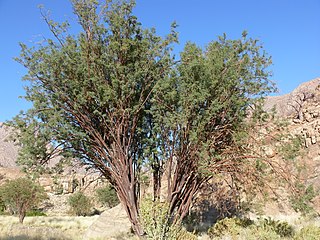
Senegalia greggii, formerly known as Acacia greggii, is a species of tree in the genus Senegalia native to the southwestern United States and northern Mexico, from the extreme south of Utah south through southern Nevada, southeast California, Arizona, New Mexico and western Texas to Baja California, Sinaloa and Nuevo León in Mexico. The population in Utah at 37°10' N is the northernmost naturally occurring Senegalia species anywhere in the world.

Senegalia senegal is a small thorny deciduous tree from the genus Senegalia, which is known by several common names, including gum acacia, gum arabic tree, Sudan gum and Sudan gum arabic. In parts of India, it is known as Kher or Khor. It is native to semi-desert regions of Sub-Saharan Africa, as well as Oman, Pakistan, west coastal India. It grows to a height of 5–12 metres (16-40'), with a trunk up to 30 cm (1') in diameter. Sudan is the source of the world's highest quality gum arabic, known locally as hashab gum in contrast to the related, but inferior, gum arabic from Red acacia or talah gum.

Acacia, commonly known as the wattles or acacias, is a large genus of shrubs and trees in the subfamily Mimosoideae of the pea family Fabaceae. Initially, it comprised a group of plant species native to Africa and Australasia, but it has now been limited to contain only the Australasian species. The genus name is New Latin, borrowed from the Greek ἀκακία (akakia), a term used by Dioscorides for a preparation extracted from the leaves and fruit pods of Vachellia nilotica, the original type of the genus. In his Pinax (1623), Gaspard Bauhin mentioned the Greek ἀκακία from Dioscorides as the origin of the Latin name.
Leslie Pedley was an Australian botanist who specialised in the genus Acacia. He is notable for bringing into use the generic name Racosperma, creating a split in the genus with some 900 Australian species requiring to be renamed, since the type species of Acacia, Acacia nilotica, now Vachellia nilotica, had a different lineage from the Australian wattles. However, the International Botanical Congress (IBC) in Melbourne in 2011 ratified their earlier decision to retain the name Acacia for the Australian species and to rename the African species.

Senegalia catechu is a deciduous, thorny tree which grows up to 15 m (50 ft) in height. The plant is called khair in Hindi, and kachu in Malay, hence the name was Latinized to "catechu" in Linnaean taxonomy, as the type-species from which the extracts cutch and catechu are derived. Common names for it include kher, catechu, cachou, cutchtree, black cutch, and black catechu.

Senegalia laeta, the gay acacia or daga, is a legume found in the family Fabaceae. It was formerly included in the genus Acacia.

Senegalia tenuifolia is a perennial climbing shrub which is native to Asia, the Caribbean, India and South America. Common names are ara a gato, bejuco cochino, tocino. It is not listed as being a threatened species. Senegalia tenuifolia grows to 8 m high and 10–15 cm in diameter.

Senegalia berlandieri is a shrub native to the Southwestern United States and northeast Mexico that belongs to the Mimosoid clade of Fabaceae. It grows 1 to 5 metres tall, with blossoms that are spherical and white, occurring from February through April. The berlandieri epithet comes from the name of Jean-Louis Berlandier, a French naturalist who studied wildlife native to Texas and Mexico. S. berlandieri contains a wide variety of alkaloids and has been known to cause toxic reactions in domestic animals such as goats.
Senegalia ferruginea is a species of plant in the family Fabaceae. It is found in India and Sri Lanka.
Senegalia flagellaris is a species of plant in the family Fabaceae. It is found only in Somalia.
Senegalia moggii is a species of plant in the family Fabaceae. It is found only in Somalia, and is threatened by habitat loss.

Senegalia montis-usti, the Brandberg acacia, is a species of plant in the family Fabaceae. It is found only in Namibia.
Senegalia robynsiana, the whip stick acacia, is a species of plant in the family Fabaceae. It is found only in Namibia.

Senegalia is a genus of flowering plants in the family Fabaceae. It belongs to the Mimosoid clade. Until 2005, its species were considered members of Acacia. The genus is still considered polyphyletic and will require further division. Senegalia can be distinguished from other acacias by its spicate inflorescences and non-spinescent stipules.
Senegalia pervillei is a species of Senegalia that is endemic to Madagascar. The species was first formally described by English botanist George Bentham in 1875 in Transactions of the Linnean Society of London. Two varieties are recognised:
Senegalia sakalava is a species of Senegalia that is endemic to Madagascar. Two varieties are recognised:

Senegalia pennata, is a species of plant which is native to South and Southeast Asia. It is a shrub or small tropical tree which grows up to 5 metres (16 ft) in height. Its leaves are bipinnate with linear-oblong and glabrous pinnules. Its yellowish flowers are terminal panicles with globose heads. The pods are thin, flat and long with thick sutures.

Senegalia caffra, also known as hook-thorn or Acacia caffra, is a tree that occurs commonly in southern Africa. Though it is cultivated, it often occurs naturally in Gauteng suburban gardens, together with Acacia karroo and Acacia robusta.
Cleistanthus schlechteri is a plant species first described by Pax, with its current name after Hutchinson; it is included in the family Phyllanthaceae.










